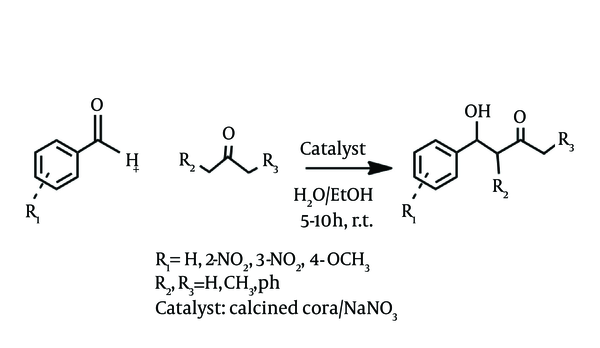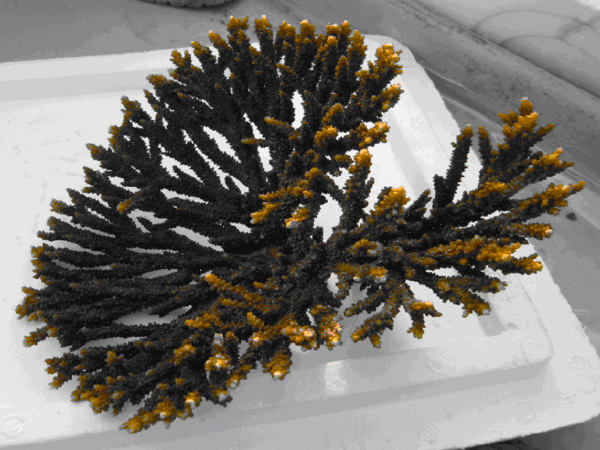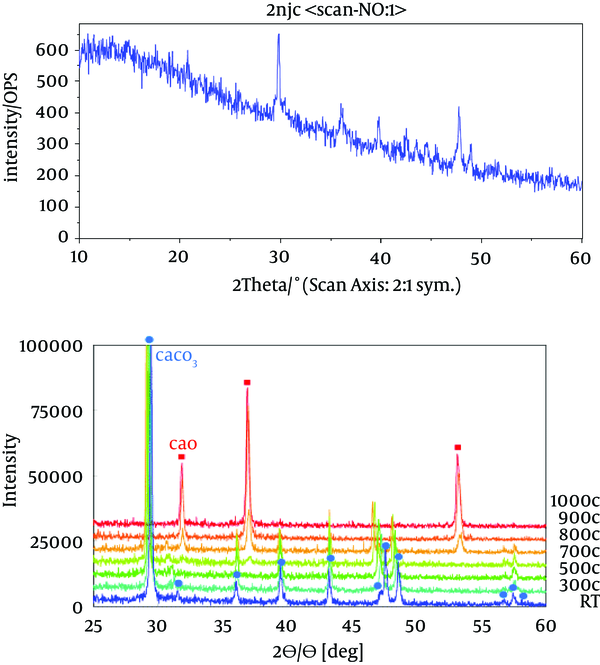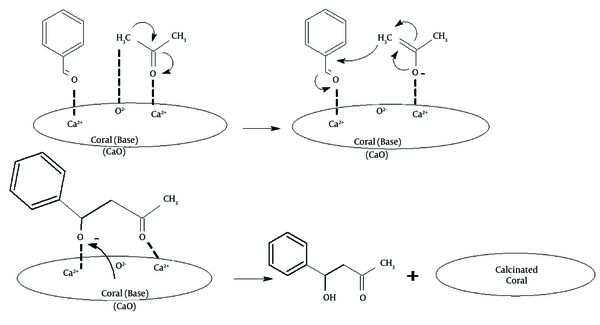Abstract
Background:
Coral, a marine organism, is known for its unique solid, natural, and efficient catalyst in organic reactions. Calcium carbonate (CaCO3), the main component of marine coral, is an efficient, basic, and natural solid for catalytic aldol condensation reaction of aldehydes and ketones having α-hydrogens to produce β-hydroxy carbonyl compounds with good yields at room temperature.Objectives:
The purpose of this research was to study using calcined coral as an efficient catalyst for aldol reaction at room temperature.Materials and Methods:
Marine coral (Acropora sp.) was washed several times using methanol-ethyl acetate and deionized water and then dried in an oven at 80°C for 48 hours. The dried coral was ground to get fine powder. For preparation of calcined coral, its powder was put in an oven at 800°C for 2 hours. Calcined coral and sodium nitrate (1:1) were well stirred in sufficient water for about 5 hours. Then, the mixture was calcined in an oven at 800°C for 2 hours. In general experiment, the reaction was carried out by mixing aldehyde (150 mmol), ketone (50 mmol), 0.1 g of calcined coral/sodium nitrate, 5 mL water-ethanol (1:1) as a solvent. Finally, the mixture was stirred at room temperature for the appropriate time.Results:
The best conditions for condensation reaction are using the calcined coral/sodium nitrate, as a catalyst in the presence of ethanol/water at room temperature. Aldol condensation reaction of nitro-substituted benzaldehydes with ketones has greater yields than benzaldehydes. Electron-withdrawing groups such as NO2 on benzaldehyde ring activate aldol condensation reaction. In comparison, 4-methoxybenzaldehyde reacts more slowly with ketones and decreases the yield of products.Conclusions:
Calcined coral/sodium nitrate as a new, efficient, and natural heterogeneous catalyst used in aldol condensation reaction of ketones and aldehydes led to β-hydroxyketones in good to high yields in appropriate condition.Keywords
Marine Coral The Persian Gulf Natural Solid Calcinated Aldol Condensation Acropora species
1. Background
Marine organisms such as corals and sponges besides helping to have a healthy environment can be used as natural solid in chemical reactions such as oxidation, pharmaceutical and biological compounds production. In order to reduce chemical pollution, preparation of natural compounds such as alkali catalysts have been considered for any chemical reactions. Given its importance as a C-C bond-forming reaction, the aldol condensation has been a common target for catalyst design. This reaction is catalyzed by alkali and acid compounds such as potassium hydroxide (1), hydrotalcites (2) and natural phosphates/KF (3). So depending on the molar ratio of substrates, temperature, catalyst and reaction condition, β-hydroxyketones or α, β-unsaturated carbonyl compounds are formed as major product (1, 4, 5). Recently, using natural substrates derived from animal sources such as bone powder and other marine resources (6) have been reported. Our group has recently developed the preparation and use of marine organisms such as sponge and coral for catalytic chemical reactions. This new natural heterogeneous method produces β-hydroxyketones in good to high yields in appropriate conditions (7).
2. Objectives
In continuation of our research program concerning the development of marine natural catalyst, we report calcined coral/sodium nitrate as an efficient natural catalyst for aldol condensation reaction of ketones and aldehydes in water-ethanol (1:1) as a solvent for 5 - 10 hours, to produce β-hydroxy carbonyl compounds (Figure 1) in good to high yields.
Aldol Condensation in the Presence of Calcined Coral/NaNO3 as a Basic Natural Catalyst

3. Materials and Methods
All materials were purchased from Merck and Aldrich companies. The IR spectra were recorded on a PerkinElmer RXI infrared spectrometer. 1H NMR spectra were recorded on a 400 MHz Bruker FT-NMR spectrometer. The X-ray diffraction was recorded on ID 3003 SIEFRET model. The purity of substrates was accomplished by thin layer chromatography (TLC) and reactions were monitored on silica gel (Merck, Germany) Polygram SIGL/UV254 plates. The melting points are uncorrected.
3.1. Preparation of Marine Coral Powder
In this study, marine corals were collected from Bushehr province coast, Iran (North coast of the Persian Gulf), in September 2012 and then washed several times using methanol-ethyl acetate and next with deionized water to remove organic compounds, extraneous, and salts. Afterwards, they were dried in an oven at 80°C for 48 hours. The dried coral was ground to get fine powder. Identification of coral, Acropora sp. was carried out kindly by Khoramshahr Marine Science and Technology University. Figure 2 shows the pictures of the Persian Gulf coral.
The Persian Gulf Coral, Acropora sp.

3.2. Preparation of Calcined Coral
Coral powder was put in an oven at 800°C for 2 hours. Then it was washed several times with water and dried again in an oven at 80°C for 24 hours. In the next step, it was washed with water and then calcined at 400°C for 4 hours. The pH of calcined coral was determined as 8 - 9.
3.3. Preparation of Calcined Coral/Sodium Nitrate
Calcined coral and sodium nitrate (1:1) were well stirred in sufficient water for about 5 hours. Then, the mixture was heated until its water evaporated and was calcined in an oven at 800°C for 2 hours. The pH of calcined coral was determined as 10 - 11.
3.4. General Procedure
The reaction was carried out by mixing aldehyde (150 mmol), ketone (50 mmol), of calcined coral/sodium nitrate (0.1 g), and water-ethanol (1:1) (5 mL) as a solvent. Then, the mixture was stirred at room temperature for the appropriate time reported in Table 1. The progress of reaction was monitored by TLC. After completion of the reaction, the products were extracted with CHCl3, and washed with distilled water. Then the solution was dried over anhydrous CaCl2 and filtered. The solvent was evaporated under reduced pressure, and the crude products were afforded in good to high yields.
Preparation of β-Hydroxy Ketones Using Aldol Reaction of Benzaldehyde and Acetone at Room Temperature in the Presence of Different Solvents and Catalysts
| Entry | Catalyst, g | Solvent | Time, h | Yield, % |
|---|---|---|---|---|
| 1 | 0.1 coral | Solvent free | 24 | _ |
| 2 | 0.5 coral | Solvent free | 24 | _ |
| 3 | 0.5 coral + 0.5 sodium nitrate | Solvent free | 24 | _ |
| 4 | 0.5 calcined + 0.5 sodium nitrate | Solvent free | 24 | _ |
| 5 | 0.5 calcined + 0.5 sodium nitrate | Ethanol | 24 | 37 |
| 6 | 0.5 coral + 0.5 calcium carbonate | Water/Ethanol | 24 | 85 |
4. Results
β-Hydroxy ketones can be synthesized via aldol condensation of the corresponding aldehydes, and ketones that involve α-hydrogen atom as starting materials. Different solids such as potassium carbonate, zeolite, and so on can be catalyzed this reaction in various solvents. Among solid catalysts, marine natural composite such as coral is mainly formed from CaCO3 and Ca3(PO4)2.
The raw materials, i.e. marine corals were collected from Bushehr province coast and then washed, dried, powdered and finally calcined in an oven at 800°C for 2 hours to remove organic materials. The obtained catalysts were characterized by X-ray diffraction and compared with similar spectrum (8) as indicated in Figure 3. Calcined coral as natural basic material was used in the aldol reaction of aldehyde and ketone with ratio 2:1, in water-ethanol solvent; but the yields of the reaction was not favored.
X-ray Diffraction Spectrum of CaO-Ref (at the Right) and Calcined Coral/Sodium nitrate (at the Left).

In order to active the marine catalyst, the modified calcined coral was prepared by impregnating the marine solid with aqueous solution of sodium nitrate, as shown in Table 1. The weight ratio used for marine solid and sodium nitrate was 1:1. The mixture was stirred vigorously at room temperature, evaporated, dried, and calcined at 800°C for 2 hours. The obtained catalyst was characterized by comparison of reported X-ray diffraction spectrum, as indicated in Figure 3.
4.1. Characterization of Products
Selected spectral data for the products in Table 2 are given (1, 6, 9, 10):
4-hydroxy- 4-phenyl- 2-butanone (Table 2, entry 1): IR (cm-1, KBr): 3450 (OH), 3026 (CH Ar), 1648 (C = O), 1625, 1589 (C = C), 824 (aromatic), 1H NMR (400 MHz, CDCl3, TMS, δ ppm): 7.65 (1H, day, = CH), 7.60 (2H, day, CH Ar), 7.50 (2H, day, CH Ar), 7.07 (1H, day, = CH), 2.42 (3H, second, CH3); 13C NMR (400 MHz, CDCl3, TMS, δ ppm): 188 (C = O), 142, 133, 132, 129, 124, 125 (125 - 142 Ar), 78 (2C = C), 29 (CH3).
1-hydroxy-2-methyl-1-phenylpentan-3-one (Table 2, entry 2): IR (cm-1, KBr): 3550 (OH) 3360 (CH Ar), 1662 (C = O), 1619 (C = C), 850 (aromatic), 1H NMR (400 MHz, CDCl3, TMS, δ ppm): 1.06 (3H, T, CH3); 1.1 (3H, day, CH3); 2.5 (2H, q, CH2); 3 (1H, qu, CH); 3.6 (1H, second, OH); 4.7 (1H, day, CH); 7.4 (2H, day, CH, Ar); 7.4 (3H, T, CH, Ar). 13C NMR (400 MHz, CDCl3, TMS, δ ppm): 180 (C = O), 145, 129, 128, 128, 128, 126 (126 - 145 Ar), 73 (2C = C), 27, 52 (CH3).
4-hydroxy-4-(2-nitrophenyl)-butan-2-one (Table 2, entry 6): IR (cm-1, KBr): 3524 - 3600 (OH), 3350 (CH Ar), 1709 (C = O), 1600 (C = C), 800 (aromatic), 1515 - 1350(NO2). 1H NMR (400 MHz, CDCl3, TMS, δ ppm): 7.5 - 7.9 (4H, M, CH, Ar); 5.50 (1H, M, CH); 3.91 (1H, br second, OH); 2.86 (1H, day, CH); 2.65 (1H, day, CH); 2.1 (3H, second, CH3). 13C NMR (400 MHz, CDCl3, TMS, δ ppm): 200 (C = O), 138, 129, 128, 128, 128, 128 (128 - 129 Ar), 63 (2C = C), 30, 48 (CH3).
4-hydroxy-4-(3-nitrophenyl)-butan-2-one (Table 2, entry 10): IR (cm-1, KBr): 3400 - 3500 (OH), 3300 (CH Ar), 1722 (C = O), 1584 - 1614 (C = C), 1515 - 1350(NO2), 810 (aromatic). 1H NMR (400 MHz, CDCl3, TMS, δ ppm): 7.4 - 8.0 (4H, M, CH, Ar); 5.2 (1H, M, CH); 3.71 (1H, br second, OH); 2.8 (2H, m, CH2); 2.1 (3H, second, CH3). 13C NMR (400 MHz, CDCl3, TMS, δ ppm): 210 (C = O), 150, 140, 133, 133, 125, 124 (150 - 124 Ar), 68 (2C = C), 51, 30 (CH3).
4-hydroxy-4-(4-methoxyphenyl)-butan-2-one (Table 2, entry 14): IR (cm-1, KBr): 3410 - 3500 (OH), 2950 (CH Ar), 1700 (C = O), 1610 (C = C), 1250 (OCH3), 800 (aromatic). 1H NMR (400 MHz, CDCl3, TMS, δ ppm): 6.9 - 7.2 (4H, day, CH, Ar); 5.0 (1H, day, CH); 4.1 (1H, br second, OH); 3.8 (3H, second, CH3); 2.8 (2H, m, CH2), 2.2 (3H, second, CH3). 13C NMR (400 MHz, CDCl3, TMS, δ ppm): 207 (C = O), 160, 136, 127, 127, 114, 114 (114 - 136 Ar), 69 (2C = C), 55, 51, 30 (CH3).
Preparation of β-Hydroxy Ketones Using Calcined Coral/Sodium Nitrate in the Presence of Ethanol/Water at Room Temperature

5. Discussion
To develop marine natural catalyst, calcined coral/sodium nitrtae was used as an efficient natural base catalyst for aldol condensation reaction of ketones and aldehydes to afford β-hydroxy carbonyl compounds in good to high yields. The obtained catalyst was characterized by X-ray diffraction signals at θ 31° and 48° in comparison with reported CaO signals at θ 32° and 47°, as indicated in Figure 3. The CaCO3 was transformed to CaO using calcination at 800°C, as shown in XRD spectrum. The observed XRD signal at θ = 31° corresponds to the existence of CaO, as shown in the desired signal in references, but the signal for CaCO3 is reported at θ = 29° (11).
According to Table 1, the best conditions for condensation reaction comprised using calcined coral/sodium nitrate, as a catalyst in the presence of ethanol/water at room temperature. Therefore, this method was used to prepare all derivatives and the results are given in Table 2. As shown in Table 2, the reaction of nitro-substituted benzaldehydes with ketones has greater yields than benzaldehydes. Electron-withdrawing groups such as NO2 on benzaldehyde ring activate aldol condensation reaction. In comparison, 4-methoxybenzaldehyde reacts more slowly with ketones and decreases the yield of products.
The plausible mechanism of the reaction of benzaldehyde with acetone in the presence of calcined coral/sodium nitrate for the formation of 4-hydroxy-4-phenyl-2-butanone is shown in Figure 4. If the reaction condition, for example room temperature is changed to reflux, by dehydration of hydroxyl ketone, 4-phenyl-2-on-3-buten is formed.
The Plausible Mechanism of Aldol Condensation in the Presence of Calcined Coral/NaNO3

Acknowledgements
References
-
1.
Singh N, Pandey J, Yadav A, Chaturvedi V, Bhatnagar S, Gaikwad AN, et al. A facile synthesis of alpha,alpha'-(EE)-bis(benzylidene)-cycloalkanones and their antitubercular evaluations. Eur J Med Chem. 2009;44(4):1705-9. [PubMed ID: 18952325]. https://doi.org/10.1016/j.ejmech.2008.09.026.
-
2.
Roelofs JCAA, Lensveld DJ, van Dillen AJ, de Jong KP. On the Structure of Activated Hydrotalcites as Solid Base Catalysts for Liquid-Phase Aldol Condensation. J Catal. 2001;203(1):184-91. https://doi.org/10.1006/jcat.2001.3295.
-
3.
Zahouily M, Bahlaouan B, Aadil M, Rayadh A, Sebti S. Natural phosphate doped with potassium fluoride: Efficient catalyst for the construction of a carbon-carbon bond. Org Process Res Dev. 2004;8(2):275-8. https://doi.org/10.1021/op034161.
-
4.
Choudary BM, Kantam ML, Sreekanth P, Bandopadhyay T, Figueras F, Tuel A. Knoevenagel and aldol condensations catalysed by a new diamino-functionalised mesoporous material. J Mol Catal A Chem. 1999;142(3):361-5. https://doi.org/10.1016/s1381-1169(98)00301-x.
-
5.
Xie Y, Sharma KK, Anan A, Wang G, Biradar AV, Asefa T. Efficient solid-base catalysts for aldol reaction by optimizing the density and type of organoamine groups on nanoporous silica. J Catal. 2009;265(2):131-40. https://doi.org/10.1016/j.jcat.2009.04.018.
-
6.
Riadi Y, Mamouni R, Azzalou R, Boulahjar R, Abrouki Y, El Haddad M, et al. Animal bone meal as an efficient catalyst for crossed-aldol condensation. Tetrahedron Lett. 2010;51(51):6715-7. https://doi.org/10.1016/j.tetlet.2010.10.056.
-
7.
Shushizadeh MR, Mostoufi A, Fakhrian M. Marine Sponge/CuO Nanocrystal: A Natural and Efficient Catalyst for Sulfonamides Synthesis. Jundishapur J Nat Pharm Prod. 2012;7(4):134-9. [PubMed ID: 24624171].
-
8.
Ivankovic H, Tkalcec E, Orlic S, Ferrer GG, Schauperl Z. Hydroxyapatite formation from cuttlefish bones: kinetics. J Mater Sci Mater Med. 2010;21(10):2711-22. [PubMed ID: 20567885]. https://doi.org/10.1007/s10856-010-4115-4.
-
9.
Amoozadeh A, Rahmani S, Nemati F. Poly (ethylene) glycol/AlCl3 as a green and reusable system in the synthesis of α, α'-bis (substituted-benzylidene) cycloalkanones: short communication. S Afr J Chem. 2010;63:72-4.
-
10.
Riadi Y, Mamouni R, Abrouki Y, El Haddad M, Saffaj N, El Antri S, et al. Animal Bone Meal (ABM): A Novel Natural Catalyst for Thia-Michael Addition. Lett Org Chem. 2010;7(3):269-71. https://doi.org/10.2174/157017810791112397.
-
11.
Olszak-Humienik M, Jablonski M. Thermal behavior of natural dolomite. J Therm Anal Calorim.